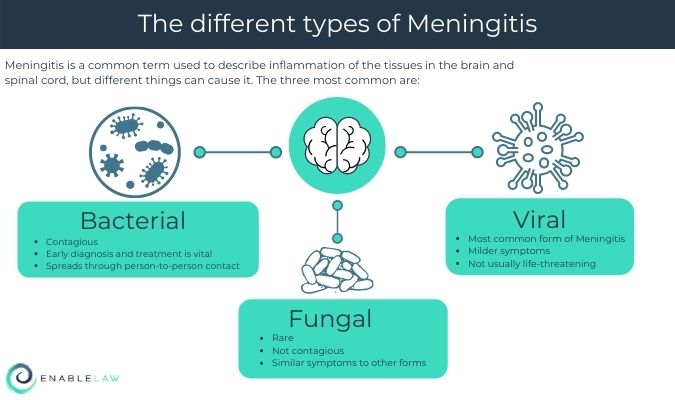Meningitis is a swelling of the protective lining of the brain and spinal cord (called the “meninges”). It is not a single disease and there are actually several types including bacterial, viral, and fungal meningitis. Some people who suffer from meningitis may also develop septicaemia (also known as blood poisoning or ‘sepsis’), which can be caused by the same germs.
In this article we will look at the main types of meningitis, the role sepsis can also play and the possible impacts of the first national lockdown on the spread of meningitis.
Bacterial Meningitis
Meningitis is usually caused by a bacterial or viral infection. Whilst viral meningitis is more common, it is bacterial meningitis which is the most serious form of the disease. It is potentially life-threatening, even with proper treatment.
Bacterial meningitis is contagious and can be spread from person to person through:
• coughing,
• sneezing,
• kissing, or
• other contact.
It usually develops when certain bacteria get into the bloodstream and travel to the brain or spinal cord. Common symptoms include:
• a fever or headache
• an increased heart rate
• neck stiffness
• reduced consciousness
Although these symptoms can appear in any order, or not at all.
There is a vaccine which helps to prevent against some forms of bacterial meningitis, but if you do contract the disease early diagnosis and treatment is vital. Diagnosis usually begins with a doctor taking a history of your health and undertaking a physical exam. A blood test can then check for bacteria or viruses, and a lumbar puncture may be needed. This is where a sample of your spinal fluid is taken and checked for bacteria or viruses.
Because the condition is very serious urgent hospital treatment is recommended. Treatment with antibiotics will usually start before you are formally diagnosed. You may then need fluids, oxygen and / or steroids.
Viral Meningitis
Viral meningitis is more common than bacterial meningitis. It is however usually milder, and often goes away without treatment. It’s not normally life threatening.
Some cases do need to be treated in hospital though, and the symptoms can be similar to those of bacterial meningitis, so it is important medical advice is sought if there are any concerns.
The viruses that cause the disease can be spread to other people in the same sorts of ways as bacterial meningitis. It is however unlikely to be spread, and connected cases of viral meningitis are extremely unusual. It is not generally considered to be contagious.
There is no specific treatment for viral meningitis. Treatment is normally aimed at reducing the symptoms, such as taking painkillers for the headache. Most people recover without treatment within 5 – 14 days, although some people can take longer to recover.
Meningitis & Sepsis
Sepsis can be caused by some types of bacteria that also cause meningitis. It can develop before meningitis, or at the same time.
It is caused when the bacteria enter the bloodstream. When in the bloodstream they then multiply rapidly and produce toxins. It is a very serious condition that can be fatal.
Sepsis can occur with or without meningitis. Symptoms can include:
• a fever
• drowsiness / confusion
• fast breathing
• shivering.
Someone with sepsis may also develop pin prick red spots, or a widespread rash. If the spots don’t disappear when a glass is pressed against the skin then medical help should be sought immediately.
Meningitis and sepsis can affect anyone, but young children are particularly at risk because their immune systems are less developed. Teenagers and young adults are also more likely than other ages groups to harbour the bacteria that cause bacterial meningitis. This is why vaccination programmes and public awareness campaigns have been focused on these groups.
There are however no vaccines to protect against certain types of the disease, so it is still important to know the potential symptoms.

Social Distancing
Invasive Meningococcal Disease (IMD) is a type of bacterial meningitis. It can develop rapidly and can be fatal even for people who were otherwise healthy.
Public Health England monitor the amount of cases of IMD in England. In January 2021 new figures were published by them which confirmed that the amount of cases dropped during 2020.
Their report showed that there were 461 confirmed cases of IMD from July 2019 to June 2020. This was 12% lower than the 526 cases reported in 2018 to 2019.
The drop was even more significant during the first national lockdown. Between April and June 2020, there were just 29 cases of confirmed IMD. This was 76% lower than in the same period in the previous year (when there had been 121 cases).
The data therefore shows that the social distancing measures introduced during the first national lockdown on 23 March 2020 had a significant impact on the spread and detection of the infection.
Only time will tell how the easing of social distancing, and the return of pupils and students to schools and universities, will impact on the rates of new cases.
Although meningitis is relatively rare, and some cases of the disease are dropping with vaccination programmes and social distancing, it is a serious condition and can leave people with lifelong injuries.
It is therefore very important to seek medical advice as soon as possible if there are any concerns about your or your child’s symptoms. Acting quickly is critical as a delay in treating meningitis and sepsis can potentially cause life changing injuries such as; brain injuries, deafness, organ damage or amputations.
If you have concerns about the treatment you or someone you know received, and you would like advice about a potential claim, then speak to Enable Law’s specialist clinical negligence solicitors in confidence today on 0800 044 8448 or contact us here.



















